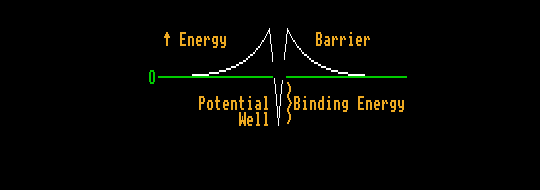

At very high temperatures, meaning high collision energies, It is possible to fuse two protium nuclei (protons) to liberate the greatest amount of energy, but this reaction is very improbable because one of the protons must simultaneously change into a neutron via the weak force (this involves inverse beta decay). The result is a nucleus of deuterium.
Much faster reactions occur with heavier isotopes of hydrogen, where no protons need change into neutrons. The fusion of two heavy hydrogen nuclei (Deuterium, D) (1p 1n) to produce one nucleus of helium (He) (2p 2n) releases huge amounts of energy mainly in the form of gamma rays. Normally however, the electrostatic repulsion between like positive charges of the constituent protons in each nucleus keeps them apart. The closer the nuclei approach, the greater is this repulsion. But, when the nuclei approach even closer, the repulsion between the protons is exceeded by the attractive but short range nuclear force, and the nuclei fuse, releasing more energy than the energy needed to push them close enough for fusion to occur. This pushing energy is normally supplied by heat energy. The hotter a gas, the higher the velocity of its particles. When the velocity of the nuclei is sufficiently high to allow two approaching nuclei to overcome the mutual repulsion between them, they fuse, sometimes by tunnelling.
To fuse deuterium in this way requires the nuclei to have a temperature of 10 million degrees kelvin. Such conditions occur within the core of the Sun and within Hydrogen bombs.
The most favourable reaction, however, is between deuterium, H-2 and tritium, H-3. Deuterium and tritium are used in fusion research because they repel each other less than any other nuclides. However, the fusion of deuterium with tritium releases energetic neutrons, which because they are neutral, cannot be confined and will irradiate any container making it highly radioactive. The other product is an alpha particle, a helium-4 nucleus.
Thermonuclear bombs (h-bombs) employ the latter reaction. Lithium deuteride, 6LiD, a heavy hydride of lithium, is the main ingredient, along with a little tritium. The neutrons liberated by the fusion of deuterium and tritium react with the Li-6 to produce more tritium, which further reacts. The extreme temperatures required for the fusion reaction are made by the detonation of a fission bomb, usually employing plutonium-239. The power liberated by such devices can total a hundred megaton equivalent of TNT.
Fusion between the scarce helium-3 and deuterium releases energetic protons, which because they are charged, can be directed by magnetic fields and decelerated through a coil directly generating electricity in the process.
![]()
![]()